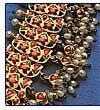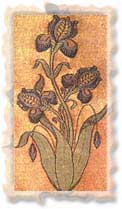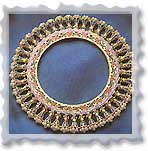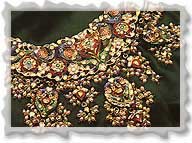

  |
Home |
 |
 eenakari the art of enameling, known as Menakari, has been an
indigenous craft of the India. Enameling was done basically to test the
quality of gold because as the saying goes, "the purer the gold, the
brighter the enamel." Hence the gold used, was of high standard of purity,
in order to produce the finest kind of enamel. eenakari the art of enameling, known as Menakari, has been an
indigenous craft of the India. Enameling was done basically to test the
quality of gold because as the saying goes, "the purer the gold, the
brighter the enamel." Hence the gold used, was of high standard of purity,
in order to produce the finest kind of enamel. An ornament is crafted in gold and then handed over to the 'Chitera' (artist) for the desired design which is then outlined by the 'Thathera' (engraver). Finally the ornament goes to the 'Meenasaz' (enameller), who applies different colours with brushes on the engraved design. The surface of the pits in the gold are ornamented with etching, which serve not only to make the enamel adhere firmly, but to increase its beauty by the play of the light and shade through the transparent colours. Before applying the enamel, the surface is thoroughly burnished and cleaned, the paint, which may have over-flowed, is carefully wiped with a piece of cotton and the article is left in the fire for half an hour for the enamel to be set firmly. It is then rubbed with corundum bone or 'Sohan' and again put in fire. The acid of tamarind or lemon is then applied to the article. While in the furnace the article to be enameled is placed on a plate of mica to keep it from direct contact with fire. It is very carefully shielded while cleaning or dying to prevent any dust attaching to it.  Colours are applied in the order of their hardiness
or power of resisting fire, beginning with the hardest. In the order of
their resistance the colour are white, blue, green, black and red. Pure
ruby is the most difficult to handle and it is only the most experienced
workers who can bring out its beauty. It was the Jaipur enameller who
alone could give a uniform transparent luster to this colour, which fascinated
all who saw it. All colour known can be enameled on to gold.
Black, green, blue, dark yellow, orange and pink can adhere to copper; of
these is the last is made to stay on with difficulty. Colours are procured
in vitreous lumps and are ground with mortar and pestle and mixed with
water. Colours are applied in the order of their hardiness
or power of resisting fire, beginning with the hardest. In the order of
their resistance the colour are white, blue, green, black and red. Pure
ruby is the most difficult to handle and it is only the most experienced
workers who can bring out its beauty. It was the Jaipur enameller who
alone could give a uniform transparent luster to this colour, which fascinated
all who saw it. All colour known can be enameled on to gold.
Black, green, blue, dark yellow, orange and pink can adhere to copper; of
these is the last is made to stay on with difficulty. Colours are procured
in vitreous lumps and are ground with mortar and pestle and mixed with
water. Enamellers from Lahore (where they migrated to, from Persia), were brought to Jaipur (Rajesthan) in the 16th -17th and 18th century. In India, craftsmen From Punjab, Jaipur, Lucknow and Varanasi possessed Knowledge about this intricate craft and the Varanasi and Jaipur enamel reached a high stage of perfection and remained un matched in any part of the country. The ornament of Kundan work are combined with enameling, so that the particular prices of jewellery has two equally beautiful surface- the precious stones set on the front side and enameling at the back. One reason why the enamel of this period has endured is, because it never come in contact with the skin. Necklaces were attached to strips of velvet, which not only proved comfortable but also prevented friction with skin and at the same time preserved the enamel. |
| All copy
right reserved 1999® This part of site designed by Enhance Net Services |